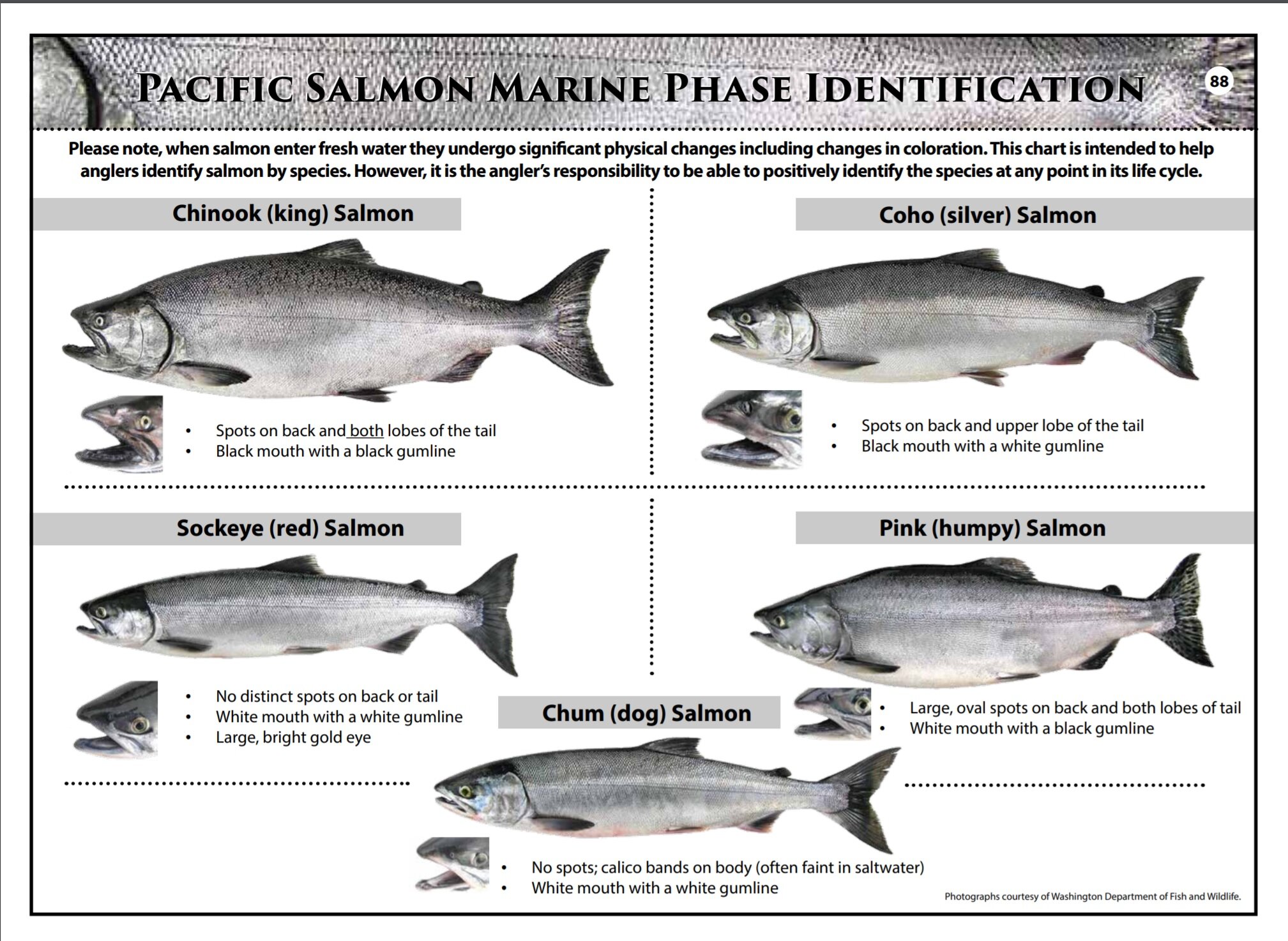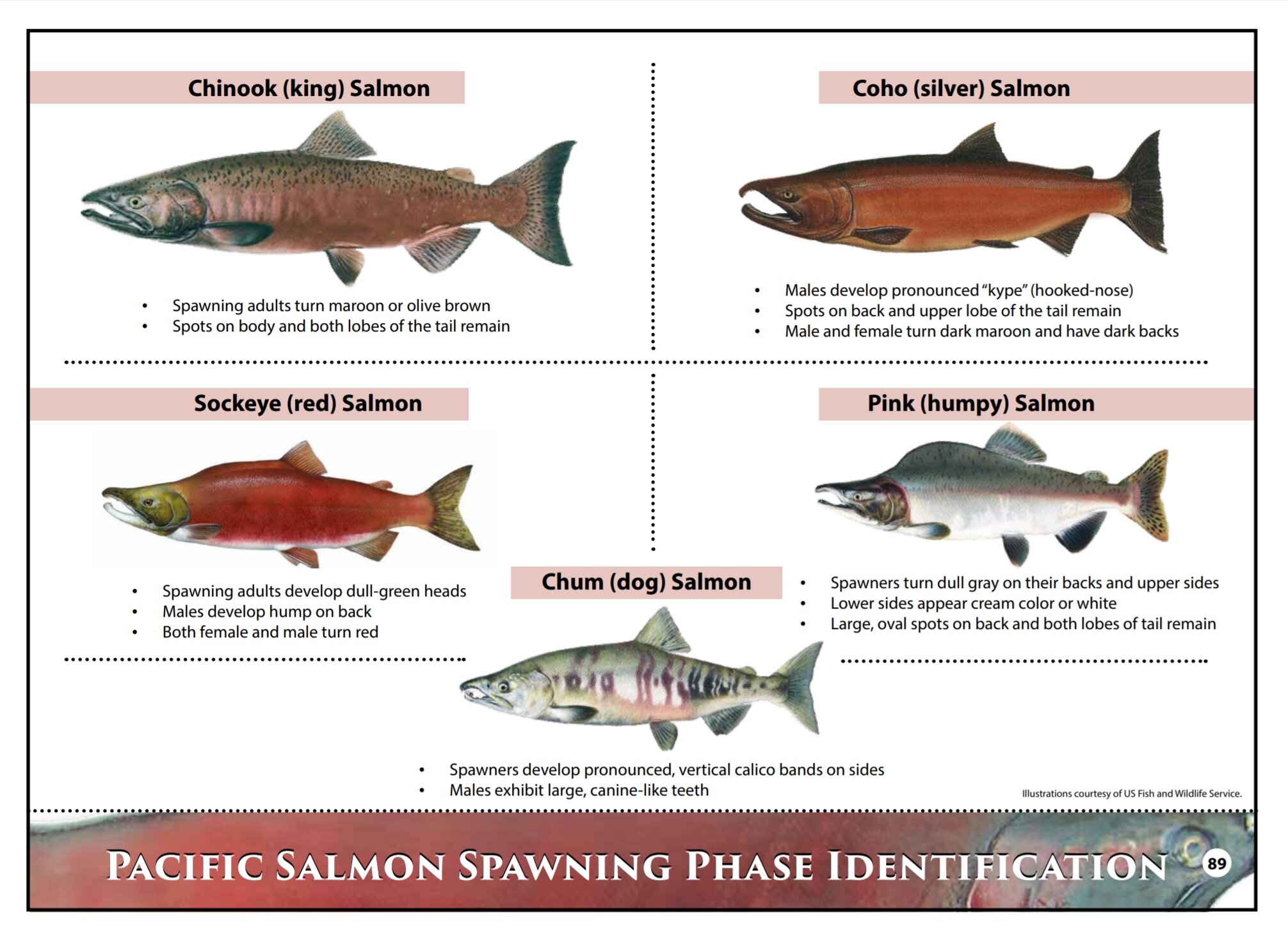Papa Bear Adventures BEGINNERs guide to salmon identification
What kind of Salmon is it?
For the individual who doesn’t get to see all 5 species of Salmon on the regular, here are some easy ways to identify what you’ve caught with out question.
The first and easiest bit of information you need is the date. Depending on what month and year you are fishing, you can know right off the bat at what Salmon to even expect on the river. On Papa Bear Adventures home page, if you click on “fishing” then “pricing and rivers,” each river has its own “fish calendar” that can be very helpful on planning and what fish to expect during your trip. For example, if you are fishing late June on the Kwethluk River, using the process of elimination, you will most likely not be catching any Reds, Pinks, or Silvers as their run happens a little latter in the season. In the case of Pinks, it actually has to do with even and odd years, so there is another elimination factor depending on what year and month it is. Why is that? Pink Salmon actually have the shortest lifespan of all the Pacific Salmon found in North America. They mature and complete their entire life cycle in two years. This predictable two-year life cycle has created genetically distinct odd-year and even-year populations of Pink Salmon. Fish coming in odd years are unrelated to the individuals returning in even years. Odd-year and even-year populations do not interbreed with each other even when they return to the same spawning grounds. Many times individual streams will tend to have one of the populations (odd-year or even-year) producing more fish. However, in some streams both odd and even years produce about the same number of pink salmon. Occasionally this will shift, and the previously weak year will become the most abundant. Weird, right? So, early June, you can expect that any Salmon that is caught will most likely be King or Dog Salmon in the Kuskokwim drainage. This is not gospel, as stranger things happen, and water level, temperatures and other factors contribute to when the Salmon run, but most of the time is correct. There is another little important piece of information that needs to known as well. Jack Salmon also run at the same time. Jacks are still King Salmon, but they have only spent 1 winter in the ocean before reaching sexually maturity. Most Kings take 5-7 years to reach sexual maturity while Jacks are from 1-3 years. Jacks are significantly smaller in size but look exactly the same. King Salmon are very easily identifiable as they are the largest of the Salmon species and on average weigh 30 lbs. The world record is 126 lbs, so they can get up there. Adults are easily recognizable by the black irregular spotting on the back and dorsal fins and on both lobes of the caudal or tail fin. Chinook Salmon also have a black pigment along the gum line, thus the name "blackmouth" in some areas. Best way to remember Kings is black gums on a black mouth. As a King begins to make its way up river, it begins to turn a red or olive color, however, the black lips and dark spots on top still remain, making them easily identifiable. Dog, also known as Chum Salmon, are also easily recognizable for their distinctive vertical stripes. They are smaller in length and much more “streamline” looking than a King Salmon. As well as the vertical stripes, Chum also have white gums on a white mouth and have no spots on their back. As the Chum begin to spawn and make there way upriver, the vertical stripes become much more pronounced, the snout and teeth of the male Chum are also very pronounced and look almost like canines. Their body has a mixture of dark green, olive, and red. Chum Salmon have the largest natural range of any Pacific Salmon, and undergo the longest migrations of the Salmon species. Pink Salmon are about the same size as a Chum Salmon, just slightly smaller. They have large black oval shapes on their back and on both top and bottom of their tail. They have a white mouth mouth with a black gum line. During spawning and as they make there way up the rivers, their backs turn kind of a dull gray while there bottoms are more of a cream color and or course they get there famous hump on their back, thus the nickname, “Humpy.” The large oval spots on the back and tail remain during the spawning phase. The Red Salmon, also know as Sockeye Salmon, is almost identical in size to the Chum Salmon. The main differences is the lack of vertical strips, which makes it easily identifiable when compared to a Chum. The Red also has a white mouth with a white gum line and has no distinct dots or markings on its back or tail. Last but not least, we have probably the most favorite of the 5 Salmon species, the Coho Salmon, better known as the Silver Salmon. The Silvers have the latest run and are roughly the same size as the Chum, Pink, and Red Salmon. They are bright silver of course, have spots on their back and tail and have a black mouth with white gums.
I have attached an identification chart for your viewing pleasure. Enjoy!


